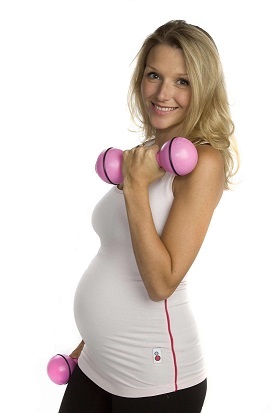The more active and fit you are during pregnancy, the easier it will be for you to adapt to your changing shape and weight gain. It will also help you to cope with labour and get back into shape after the birth. Here’s the lowdown on pregnancy and exercise, from getting started to staying motivated. Pregnancy might seem like the perfect time to sit back and relax. You likely feel more tired than usual, and your back might ache from carrying extra weight. But unless you’re experiencing complications, sitting around won’t help. In fact, pregnancy can be a great time to get active — even if you haven’t exercised in a while.
Why exercise during pregnancy?
During pregnancy, exercise can:
- Reduce backaches, constipation, bloating and swelling
- Boost your mood and energy levels
- Help you sleep better
- Prevent excess weight gain
- Promote muscle tone, strength and endurance
- Exercise during pregnancy might also reduce the risk of gestational diabetes.

Pregnancy and exercise: Getting the OK
Before you begin an exercise program, make sure you have your health care provider’s OK. Although exercise during pregnancy is generally good for both mother and baby, your doctor might advise you not to exercise if you have:
- Some forms of heart and lung disease
- Preeclampsia or high blood pressure that develops for the first time during pregnancy
- Cervical problems
- Vaginal bleeding
- Placenta problems
- Preterm labor during your current pregnancy
- A multiple pregnancy at risk of preterm labor
- Premature rupture of the membranes
- Severe anemia
Pacing it for pregnancy
For most pregnant women, at least 30 minutes of moderate exercise is recommended on most, if not all, days of the week. Walking is a great exercise for beginners. It provides moderate aerobic conditioning with minimal stress on your joints. Other good choices include swimming, low-impact aerobics and cycling on a stationary bike. Strength training is OK, too, as long as you stick to relatively low weights. Remember to warm up, stretch and cool down. Drink plenty of fluids to stay hydrated, and be careful to avoid overheating. Intense exercise increases oxygen and blood flow to the muscles and away from your uterus. In general, you should be able to carry on a conversation while you’re exercising. If you can’t speak normally while you’re working out, you’re probably pushing yourself too hard.

Depending on your fitness level, consider these guidelines:
You haven’t exercised for a while. Begin with as little as five minutes of physical activity a day. Build up to 10 minutes, 15 minutes, and so on, until you reach at least 30 minutes a day.
You exercised before pregnancy. You can probably continue to work out at the same level while you’re pregnant — as long as you’re feeling comfortable and your health care provider says it’s OK.
Staying motivated
You’re more likely to stick with an exercise plan if it involves activities you enjoy and fits into your daily schedule. Consider these simple tips:
- Start small. You don’t need to join a gym or wear expensive workout clothes to get in shape. Just get moving. Try a daily walk through your neighborhood or walk the perimeter of the grocery store a few times. Take the stairs instead of the elevator.
- Find a partner. Exercise can be more interesting if you use the time to chat with a friend. Better yet, involve the whole family.
- Try a class. Many fitness centers and hospitals offer classes, such as prenatal yoga, designed for pregnant women. Choose one that fits your interests and schedule.
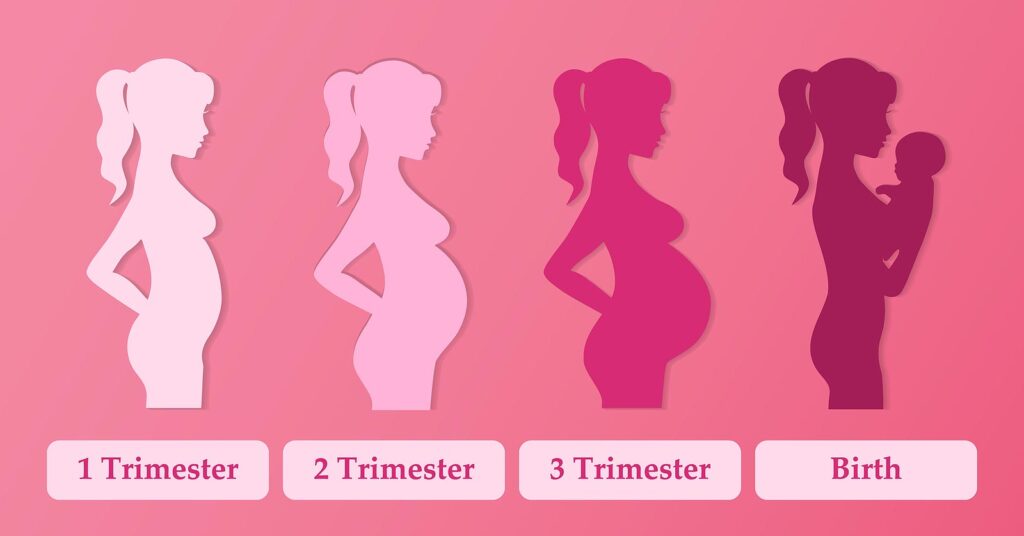
Benefits of exercise after pregnancy
Regular exercise after pregnancy can:
- Promote weight loss, particularly when combined with reduced calorie intake
- Improve your cardiovascular fitness
- Strengthen and tone abdominal muscles
- Boost your energy level
- Relieve stress
- Promote better sleep
Better yet, including physical activity in your daily routine helps you set a positive example for your child now and in the years to come.
When to start after pregnancy
If you had an uncomplicated vaginal delivery, it’s generally safe to begin exercising a few days after giving birth or as soon as you feel ready. If you had a C-section, extensive vaginal repair or a complicated birth, talk to your health care provider about when to start an exercise program.
Physical activity goals
For most healthy women, the Department of Health and Human Services recommends at least 150 minutes a week of moderate-intensity aerobic activity — preferably spread throughout the week — after pregnancy. Consider these guidelines:
- Take time to warm up and cool down.
- Begin slowly and increase your pace gradually.
- Drink plenty of fluids.
- Wear a supportive bra and, if you’re breast-feeding, nursing pads in case your breasts leak.
- Stop exercising if you feel pain.
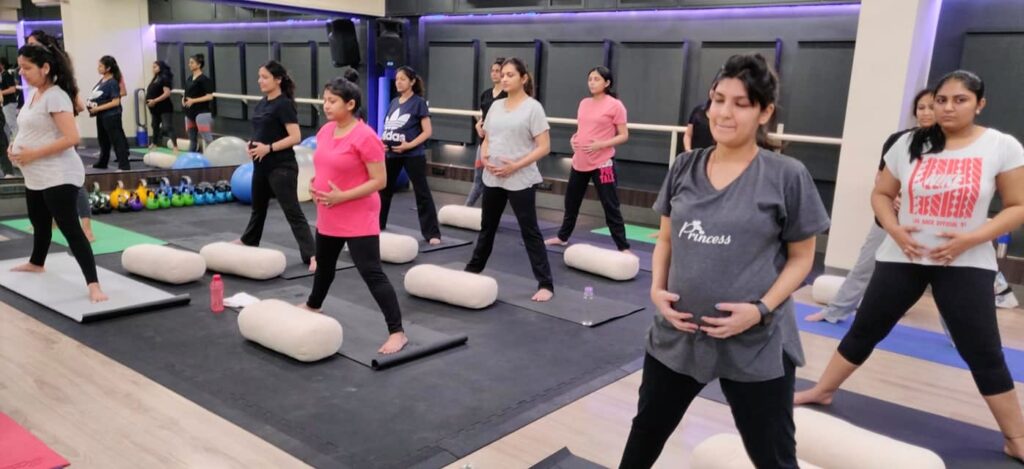
Activities to try
- Cardio training. Start with something low impact and simple — such as a daily walk. If you’re looking for camaraderie, see if you can find a postpartum exercise class at a local gym or community center. With your health care provider’s OK, also consider these specific exercises:
- Pelvic tilt. Try the pelvic tilt a few times a day to strengthen your abdominal muscles. Lie on your back on the floor with your knees bent. Flatten your back against the floor by tightening your abdominal muscles and bending your pelvis up slightly. Hold for up to 10 seconds. Repeat five times and work up to 10 to 20 repetitions.
- Kegel exercise. Use this exercise to tone your pelvic floor muscles, which support the uterus, bladder, small intestine and rectum. Contract your pelvic floor muscles, as if you’re attempting to stop urinating midstream. Hold for up to 10 seconds and release, relaxing for 10 seconds between contractions. Aim for at least three sets of 10 repetitions a day. Avoid Kegel exercises when urinating.
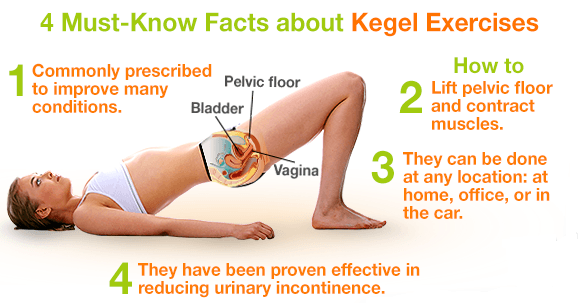
- Weight training. Weight training during pregnancy can be a great partner to other types of moderate exercise, like walking or swimming. Lifting weights strengthens muscles throughout the entire body and can help you feel better on the inside and out. If you regularly lifted weights before pregnancy, you very likely can continue with some modifications. If you’re new to lifting, you should probably speak with your doctor first. Lifting weights during pregnancy not only can help you stay fit, but it can help you prepare your body for parenthood. When done correctly and with the appropriate weight, strength training is quite beneficial. Here are the benefits of weight training when you’re expecting.
- Strengthens back muscles. Lower back pain is a common complaint during pregnancy, affecting approximately two-thirds of all pregnant people. This is because a growing uterus and enlarged breasts can shift your center of gravity and increase the curvature of your back, which puts extra strain on the back muscles. Lifting weights can strengthen back muscles and increase core strength, which helps support the additional weight of your changing body.
- Easier labor. Research shows that exercise, particularly resistance training, has a positive effect on labor outcomes. It can decrease the chance of cesarean delivery and decrease the length of a hospital stay; lower the chance of an instrumental delivery; shorten the early stages of labor. And try not to worry about going into early labor because of your workout; studies also show that resistance exercises do not increase the risk of preterm labor.

- Better weight management. Pregnancy weight gain is expected and important to support the growth of your baby. Too much weight gain, however, may lead to health problems, like gestational diabetes and hypertension while increasing the risk of obesity in your child. It can also increase your risk of obesity after pregnancy. Too little weight gain can lead to your child being too small; this increases their risk of illness and may lead to developmental delays. Research shows a regular exercise program, including strength training with weights, can help control excess weight gain during pregnancy. There is also evidence that maintaining a lower weight during pregnancy can help prevent preeclampsia.
- Lowers the risk of gestational diabetes. Pregnancy can also put you at risk of developing gestational diabetes mellitus (GDM), a form of diabetes that occurs during pregnancy. Usually, high blood sugar levels return to normal after pregnancy, but GDM can increase your risk of developing type 2 diabetes later in life. It can also increase your baby’s risk of obesity, impaired glucose tolerance, and type 2 diabetes. Including resistance training in your prenatal workouts has been shown to lower the risk of developing GDM.
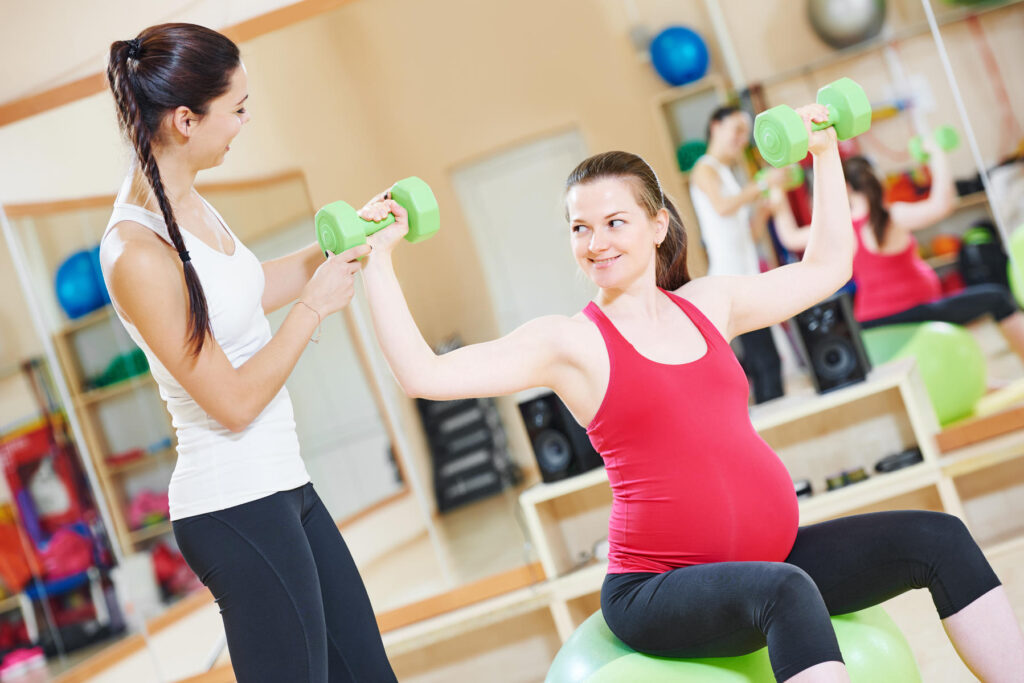
Precautions:
- There are certain precautions you should take when you are starting any workout routine during pregnancy, including weight training. These measures reduce the risk of complications and injuries to you and your baby.
- Avoid lying on your belly or back. Laying on your back in the second and third trimester causes the uterus to compress the vena cava, a major vein that carries deoxygenated blood to the heart. This reduces the flow of blood oxygen to the baby. Avoid exercises in a supine position, like bench press or prolonged floor work. Instead, modify your position so that you are inclined, sitting, or upright. For example, a chest press can be performed on an incline bench after 12 weeks. After 20 weeks you can practice it with a further incline. It is also important not to use machines that place excessive strain on your lower back and those with a pad that presses down on your belly.
- Be careful of the abdominals. During pregnancy, the muscles that meet in the middle of your stomach stretch to create space for a growing uterus. It is common for the rectus abdominis to separate; this is called diastasis recti (DR). DR can also be caused by incorrectly lifting heavy weights or performing unsafe or excessive abdominal exercises. This includes moves that require you to lie on your belly after the first trimester. Many trainers recommend focusing on strengthening the pelvic floor and core muscles, rather than traditional ab exercises.
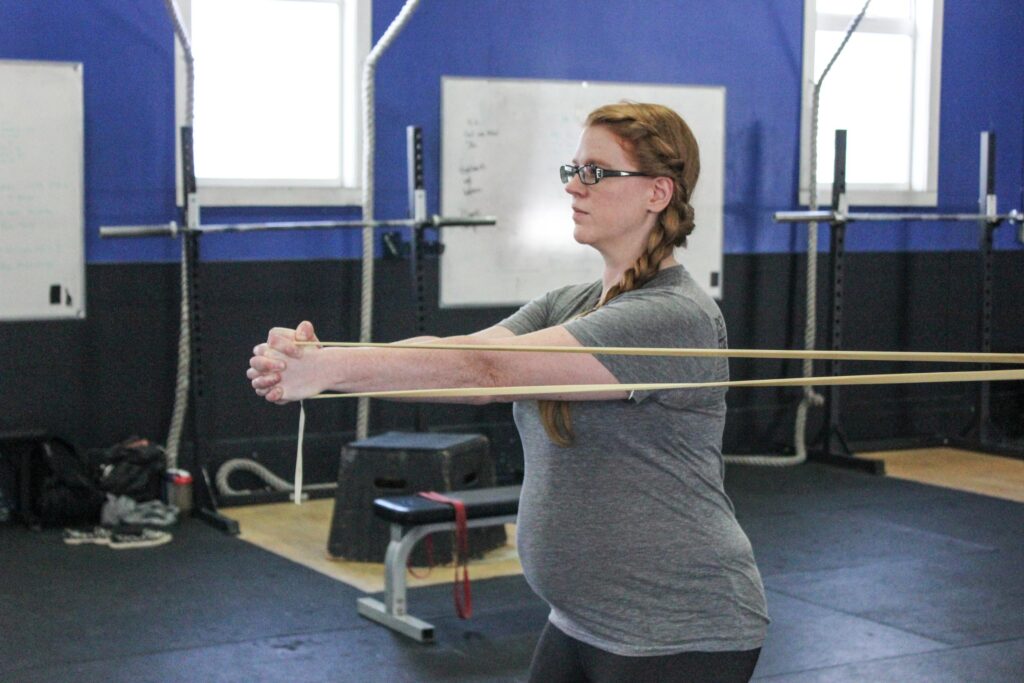
- Use lighter weights. During pregnancy, the placenta produces a hormone called relaxin, which loosens your joints and ligaments in preparation for delivery. As a result, any high-impact exercise, including weight training, can make you more prone to injury, strains, and sprains. To avoid overloading loosened joints, trainers suggest using lighter weights and doing more repetitions. If you are unsure about using weights and still want to include resistance training in your workout, try bodyweight exercises; using your body as resistance to build strength.
- Avoid lifting weights above your head. As the uterus shifts forward, it also changes the orientation of the pelvis and may cause further stress on the lower back and pelvis. Additionally, weight gain is focused on your midsection during pregnancy, which changes your center of gravity. This alters your posture and balance, which can lead to an arched lower back, slouched shoulders, and lower back pain. Lifting weights above your head can increase the curve of your lower spine and exacerbate lumbar stresses. Avoid exercises like shoulder presses after the first trimester.
- Avoid bending forward at the hips and/or waist after the first trimester. This may make you feel dizzy. As your belly grows, you may also find it hurts your lower back.
- Avoid vigorous exercise. During vigorous exercise the blood flow to the placenta is reduced; this results in a decrease in oxygen going to the fetus. The resultant disrupted flow of oxygen is not only dangerous for your baby, but it can make you lightheaded and lead to cramping.

Listen to your body
As important as it is to exercise, it’s also important to watch for signs of a problem. Stop exercising and contact your health care provider if you have:
- Vaginal bleeding
- Dizziness
- Headache
- Increased shortness of breath
- Chest pain
- Uneven or rapid heartbeat
- Uterine contractions that continue after rest
- Fluid leaking or gushing from your vagina
- Decreased fetal movement
- Calf pain or swelling
- Muscle weakness affecting balance
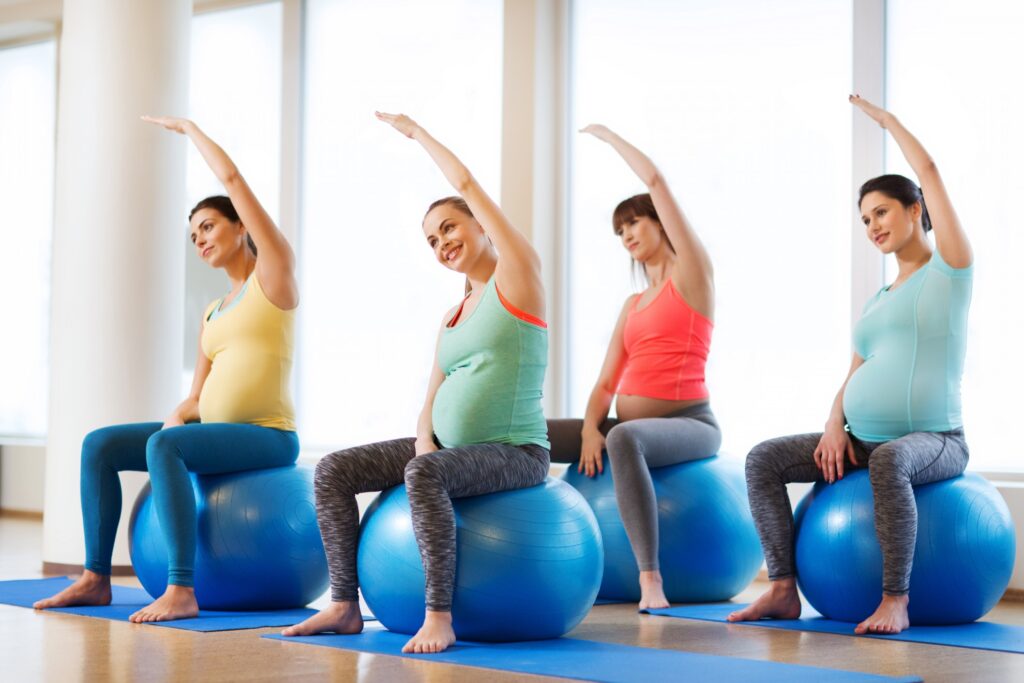
Overcoming barriers
When you’re caring for a newborn, finding time for exercise can be challenging. Hormonal changes can make you emotional and some days you might feel too tired for a full workout. But don’t give up. Seek the support of your partner, family and friends. Schedule time for physical activity. Exercise with a friend to stay motivated. Include your baby, either in a stroller while you walk or lying next to you on the floor while you do abdominal exercises. Exercise after pregnancy might not be easy — but it can do wonders for your well-being, as well as give you the energy you need to care for your newborn.

Dr Saranjeet Singh
Fitness & Sports Medicine Specialist
Lucknow (UP), INDIA

